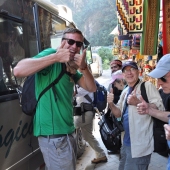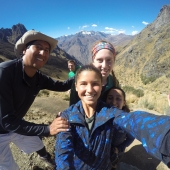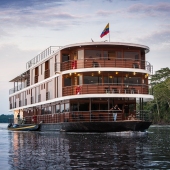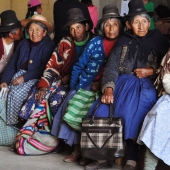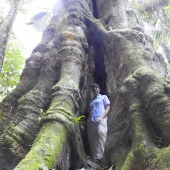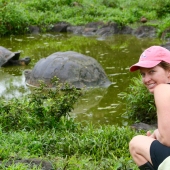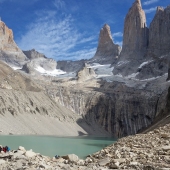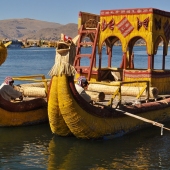
How We Got to Machu Picchu On "The Wings Of A Condor"
Fortunately, it's not often that something goes horribly wrong on a trip. Issues with hotel reservations, tardy flights, missed trains or buses are one thing, but getting stranded in a far-flung location during a mudslide on the way to Machu Picchu is a once in a lifetime occurence. In 17 years of exploring Peru, nothing like this has ever happened to me or anyone I know. It was a fluke. A wild card, A chance occurence that just happened. And depending on how you look at it, we were in the wrong place at the wrong time. Or maybe not. What happened after the slide was a remarkable collision between the destructive elements of mother nature and a chance for me to face my own raw fear.
Best little hike in Peru
One of my favorite activities in Peru is a 3 hour flat, easy, 8 mile/12km hike on the backside of Machu Picchu. I've done it several times. It's a fantastic activity for nature-lovers and active travelers of all ages. The trickiest part of the hike is not the hike itself. It's getting to the hike. Luckily. I know people. So driving 7 hours from Cusco to the small village of Santa Teresa, over 15,000 ft Abra Malaga mountain pass, is simply a matter of organizing with the right person.
When are mudslides most likely to occur in Peru?
Mudslides are pretty common in Peru, especially towards the end of the rainy season which begins winding down in late February. (rains begin around late December and taper off in March. But it can rain anytime year round) After a season of regular rain, the mountainous terrain gets saturated and before you know it, chunks of mountains slip off like candy sprinkles dripping down an ice cream cone. Slides can happen anywhere and train companies have organized their routes to avoid traveling through landslide-prone territory during the latter part of the rainy season. (January 1 through May 1)
The day of our little hike on the backside of Machu Picchu
So, with 25 people, age 6 to 68, I embarked on this flat, easy 8 mile hike with our licensed Peruvian tour guide, whose identify shall remain secret, on a partly cloudy, warm afternoon in late April. (the reason for secrecy will become clear later in the story). The fact that we were running a little late, which is usually the case with any large group, turned out to be an important factor that may have determined the destiny of every single member in our group.
After a sensible Peruvian lunch, we hoisted our backpacks around our plumped up bellies and began what we thought would be an effortless hike to the village of Aguas Calientes at the foot of Machu Picchu. As we walked, we explored the dense verdant setting, breaking into small groups on the dirt and gravel path next to the railroad tracks beside the Urubamba River. Steamy hot springs in Aguas Calientes awaited those who desired the.idea of a soak after the hike. And the visit to Machu Picchu was scheduled early the next morning. Our Peruvian tour guide hiked up front with the speedy "front-runners" in our group, and I brought up the rear with a small group of 7-8 people. About half way trhough the 8 mile hike, we encountered small groups of hikers coming back towards us. These hikers, of assorted nationalities, were not accompanied by local tour guides. They excitedly reported that a mudslide had just taken out an essential bridge to get to Aguas Calientes. They decided to return on foot to the hydroelectric station, which was closed due to a previous landslide, and where they hoped they could procure transportation over the rough dirt roads to get back to the village of Santa Teresa. From there, they would need to find transport for a 5 hour drive over mountainous dirt roads undergoing major construction, This would take them up out of the semi-tropical high jungle to the 15,000 ft Abra Malaga mountain pass, and then descend and finally drive to the village of Ollantaytambo. It would only be another 2 hours by train, assuming they could find seats, to get to the village of Aguas Calientes and then they could take the shuttle bus to Machu Picchu. This is why it was not ideal for our group to return to hidroelectric station. The remotely located station was closed due to the suspension of train service to and from Aguas Calientes because of another mudslide about 2 weeks earlier. The chances of a group our size finding transport back to Santa Teresa and ultimately to Ollantaytambo in time to make it for our early morning visit to Machu Picchu was slim. Actually, it was not likely.
Not knowing the status of other hikers in the front of my group, I continued toward the mudslide, where I found our tour guide and all members of our group safely sheltered out of harms way. Our experienced native tour guide found a spot for us to hang out while he approached the area where the breech had occurred. A team of local workers had been clearing debris and silt from the previous mudslide so that train service could be restored to the hidroelectric station. The new mudslide created a deep fissure through a field of massive boulders, mangled trees and unimagineable amounts of silt that turned out to be like quicksand if you accidentally stepped on it. On various occasions, most of us were caught off guard and stepped onto what appeared to be firm mud, only to have a shoe suctioned off our foot! Fast, brown, raging water surged through the deep chasm in the wooded mountain landscape and emptied into the Urubamba River where it would continue to the Amazon River and ultimately dump into the Atlantic Ocean. Our mission was to cross that chasm to get to the trail that would take us to the village of Aguas Calientes and the comfort of our hotels.
Why didn't the local police offer to help stranded hikers on the way to Aguas Calientes?
Police officers from the village of Aguas Calientes showed up on the other side of the fissure to survey the damage and I'm guessing they were also there to determine if anyone was missing, injured, or dead. Some of the local men who had been working to clear up the first mudslide were also located on the wrong side of the fissure and were contemplating building a bridge across the gap in the terrain. However they were not happy about helping out 30 or more stranded gringos and told our tour guide they would hike back to the hidroelectric train station and take their chances getting to the village of Santa Teresa for the night. So our local tour guide was the only Peruvian who was willing to assist the stranded tourists. Not even the local police offered any assistance, advice or suggestions for gringos trying to get to Machu Picchu. They told us only one thing. "Do not build a bridge!"
The Plan.
The first thing we decided was that we needed to build a bridge. Our group included healthy, fit men and women in the prime of their lives, many of whom had hands-on experience operating construction and farm machinery as well as building structures. So our Peruvian tour guide thought it was feasible to build a bridge and continue our hike to the village of Aguas Calientes that night, Everyone agreed that was the best course of action and they were confident they could pull it. The first thing we had to do was trick the police into thinking we were hiking back to the hidroelectric station. We gathered up our group and pretended to walk away and then when we got out of view, we hid in the debris. With boulders the size of small cars and the uneven terrain, that would not be a problem. So 30 of us literally sat down altogether on the ground between boulders. .
Some folks out there may be wondering why we chose to disregard the instructions of the local authorities. That's a legitimate question. From our tour guide's perspecive, the police showed up and had the chance to get involved to assist us with an alternate scheme to meet our deadline to get in to Machu Picchu or put us in contact with authorities who could help us in a manner they deemed would be practical and safe for everyone. There were at least a dozen local "mudslide engineers" working to clear the previous earthfall and they had a bulldozer located on our side of the chasm. It didn't take long to realize that what we thought would be a team approach to solving the problem, became a situation where it was "every man for himself." Everyone abandoned us and we were on our own. We were stuck between a rock and a wet place. Our entire group was in on this scheme to build a bridge to get to Machu Picchu!
Building the bridge to get to Machu Picchu
We sat in the mud and the tumbled rocks until we heard the train whistle which we interpreted to mean that the authorities left the scene and went back to Aguas Calientes. The men and older teens went off to survey the gap and start the search for lumber to span the divide. Meanwhile, women and younger kids stayed put. We were close enough to the woods that if another slide occurred, we stood a chance to dash for cover. The men would be on their own. We sang songs, told stories and shared snacks. Everyone was in good spirits and we waited for the men to let us know when it was time. We took stock of all the resources we had on hand. How much water, snacks, rain gear, headlamps, flashlights and toilet paper. We were confident if we absolutely had to,, we could survive for at least one night. Darkness descended and we huddled closer trying to keep the kids near us by telling stories.
The Bridge Crossing
As soon as we settled into a groovy vibe with our stories, one of the teen boys came over to lead us up to the newly made bridge. The sky was spitting rain and we needed to get across in case a real rain kicked in. The men were still laying the final logs as we hiked up the mountain to the spot where each person would cross one at a time. It was now completely dark and flashes of headlamps and cell phone lights darted back and forth across the chasm as the men continued working. Our tour guide was on the other side directing the final touches as the last log went down. As soon as I saw the bridge I thought it was brilliant. It was not a flat "gringo" bridge with logs laid side by side across the span. It was what I call a 3-point Inca Bridge. I have seen many authentic Inca rope bridges and this was a log version of the rope bridge. A total of 3 sturdy logs were strategically placed so that one log was centered and low, with 2 logs that were placed one on each side of the center log so you could hold on while you walked across the center log. The kids went across first with their parents assisting. The youngest held on to her father like a champanzee as he walked across. Then the older folks went. When it was my turn, I had visions of falling off the balance beam in high school PE class. So I compensated by placing each foot on a diagonal on the center log. The 2 side logs were low enough that it was necessary to stoop low to maintain balanced grip. Both hands had to be completely free from holding anything. Nothing was allowed to dangle. No backpacks, water bottles, flashlights or cameras could be carried. Eventually everyone made it across and our tour guide went back and forth with our backpacks and gear. The next phase of our little adventure was unexpected.
The unexpected descent to get back on the trail to Aguas Calientes
I didn't realize how far up the mountain we were at the time. But it took maybe an hour to descend through the debris field in the dark to get down to the raiiroad tracks and the easy hiking trail to the village. As our lights started to dim and die, we scrambled over giant boulders, under massive logs and between branches ripped into jagged giant toothpicks. And then there was the ever sneaky dern sinking mud! The nimble teens scouted for the best routes and every time I put my hand out into the darkness to grab on to something, a hand was there to help me. We all helped each other. Aside from the noise of the raging river, our voices echoed in the natural suurroundings as we descended. "Don't come this way guys! I just sank into a huge mud pit!" Flashlights and cell phone lights flashed like lasers through the trees until we finally leveled off at the beloved railroad tracks.
The final hike to Aguas Calientes
You would think the adventure was all under control at that point. We reached the flat easy trail right? But reality dictated otherwise. With dimming lights and bruised bodies we now had a 1.5-2 hour hike ahead of us. Mostly in the dark. It was an improvement over the last 4-5 hours for sure. No one was hurt or injured. But some of us were digging deep to fan the last sparks of energy needed to get to civilization. And our hotel. We trod on, breaking up into fast and slow groups. I was in the rear again with a handful of hardy middle aged, adventure-minded warriors! Our tour guide was now with us because he decided the front-runners had a straight shot to get to the village where they would be fine. With our tour guide marching in front of us on his own, we plodded by 2 police officers standing in the spot light of one of the buildings in the train operations area about a mile from the village. Our tour guide walked by the officers without a word. But when the last two dudes in our group marched by, the officers stopped them and asked, in Spanish, how they got over the broken bridge. One guy was pretty fluent and told them we "flew over the broken bridge on the wings of a condor." Then laughed heartily. The officers asked if we were assisted by any Peruvian officials. The answer was, "No, only the condor!" And we continued walking. The officers caught up with the two guys on the road to Aguas Calientes and asked if they could have their photos taken with them. They politely declined and kept walking. All the way to their hotel.
One of the important takeaways is that we were traveling with a licensed, experienced local tour guide. This was critical in making decisions. The primary concern was everyone's sadety. And the secondary concern was the ability to stay on track to get to Machu Picchu.
List of gear I wish I had brought with me:
- electrolyte powder (I was able to bum some off another hiker)
- mylar survival blanket
- jerky (snack)
- rope (parachute cord would have been perfect)
List of gear I was grateful I had:
- headlamp with rechargeable battery/USB cable
- hearty snacks (nuts and dried fruit)
- external battery to recharge phones and headlamps
- rain gear and backpack raincover
- pocket knife


